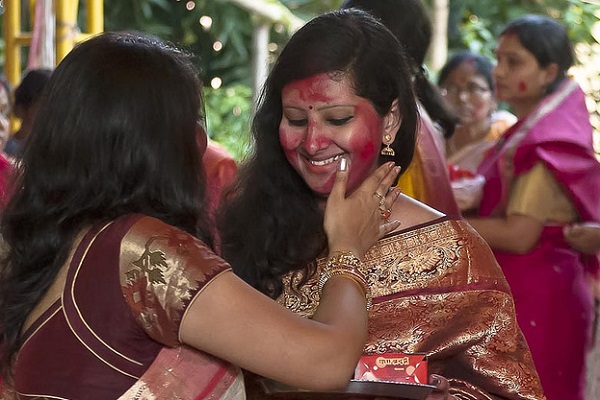
What’s the Significance of the Red Powder Hindu Women Wear on Their Heads?
- By Elisa Meyer --
- 03 Sep 2016 --

Exploring the meaning behind the Hindu tradition of wearing sindoor.
Hinduism is not just a religion but a set of common cultural ways of life. Though from a distance these cultures look similar, closer examination will shows differences according to different regions of India. Few things are actually commonly practiced by every Hindu community. However, the application of the “sindhoor” or “kumkumam” (vermilion) is one practice similar in many Hindu communities.
What’s the significance of the red powder Hindu women wear on their heads?[/tweetthis]
It should be pointed out here that vermilion is not only worn by women, but by men as well. The only difference being that women wear it as a streak in the partition of their hair on the middle of their scalp starting from top of the forehead, while men wear it mainly as a streak or dot starting between the center of their eyebrows. However, there is no fixed rule for this and the method of application differs from region to region and community to community. In general, only married women apply the vermilion on their forehead. However, in certain South-Indian communities it is applied on that spot even by unmarried women and also by men.
The color red is associated with the Divine Feminine, usually embodied in the form of Goddess Adishakti, the consort of Lord Shiva. It represents engagement in worldly life and as such is a symbol of marriage, wealth and prosperity. Traditionally vermilion is composed of turmeric powder treated with mercury and lime which give it a deep red hue. As such, it has medical benefits on regular application.
Hindu spirituality centers on the awakening of the seven chakras or power-centers starting from the base of the spinal cord up to the brain. Regular application of vermilion on the top of the forehead, the middle of the eyebrows (where the third eye, which corresponds to the pineal gland, is situated), the throat and the chest makes one focus on the chakras situated at these centers regularly. This leads to the activation of these chakras by regular focus and acupressure due to the pressing force of the finger.
A girl’s arrival into her role as the married woman is symbolized by the pinch of red powder sindoor on her head http://t.co/32KQn6pUno
— Kate Smith (@colorexpert) August 25, 2014
Despite India's vast cultural differences, the vermilion is one custom that is universally accepted as a symbol of auspiciousness. Even communities such as the Kodavas of Coorg in South India, though not falling under the mainstream Hindu culture (they trace their origins to Alexander's Persian soldiers) use it in their customs that are really very different from mainstream Hindu culture. Needless to say, the symbolic red vermilion is the identity of an Indian, and acts as a common ground for the otherwise diverse cultures she is the mother of.


















